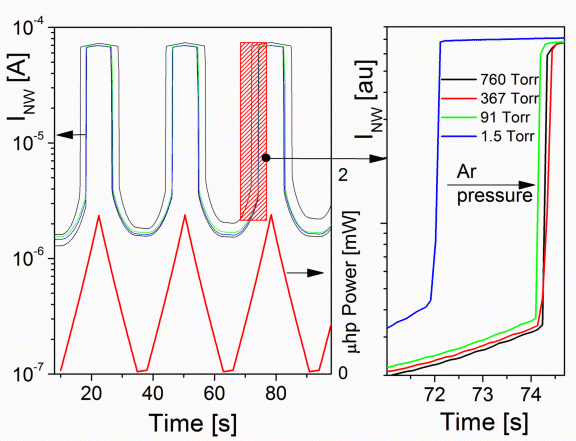Reports: G5
45842-G5 Visualizing the Interplay Between Electronic Excitations and Surface Chemistry of the Functioning 1-D Metal-Oxide Nanostructures
The two main factors which define the performance of the gas sensors are their receptor and transduction functions. The first defines the interaction of the analyte molecules with the surface of the sensing element: its rate, selectivity and reversibility. The second is the mechanism of conversion of this interaction into the output signal.
Here we proposed and tested a new type of gas sensor where the pressure dependent onset of metal-insulator transition (MIT) in single crystal suspended VO2 nanowire (NW) was used as a sensor signal. Our design of the VO2 nanowire sensors allows two practical regimes of its operation as TES-like nano-thermistor: (i) when external micro-heater is used to induce MIT and (ii) when Joule heat released in the biased nanostructure is sufficient to trigger MIT. Figure 1 shows the NW current responses to three temperature cycles of the µhp heater. When the power of the micro-heater is sufficient for VO2 nanowire to reach ~ 68 C, the conductance exhibits reproducible jump due to MIT. When power is decreasing the nanowire returns back to semiconducting state. A noticeable hysteresis in forward and back transitions is observed in this detection mode due to unequivalent initial conductance prior to the transition. As the power, required to trigger transition in the NW, follows fine balance with thermal looses of µhp to environment, the transition power in this operation mode is a function of the type of the environmental gas and its pressure (temperature). The latter can be seen in the Fig.1 (right panel) as a significant increase of the MI transition power with the pressure of the ambient gas.
|
Figure 1. Left: the current response (top) to three ramps of µhp heating power (bottom) at few values of Ar pressure. Right panel: the MIT region enlarged.
|
 To reduce (i) the
thermal inertia (and therefore sensor's response time) and (ii) the power
consumption of the sensor, we employed the self-heating mode of operation,
where the Joule heat, released in the NW during the bias ramp, was used to
trigger MIT.
To reduce (i) the
thermal inertia (and therefore sensor's response time) and (ii) the power
consumption of the sensor, we employed the self-heating mode of operation,
where the Joule heat, released in the NW during the bias ramp, was used to
trigger MIT.
The proposed sensors are able to operate in a wide pressure range and offer potentially excellent sensitivity to a large moiety of chemically inert and reactive gases. The performance of the sensor can be further improved by optimization of the nanowire length and diameter. Another possible way to increase the sensitivity and selectivity of the proposed sensor will be via improving the coupling between surface redox reaction and MIT in VO2 NW via using VO2 NW with surfaces functionalized with catalyst and employing the exothermicity of the redox reaction to trigger MIT. In addition to gas sensorics these kind of devices can be used as nanoscopic anemometers and nano-bolometers.




